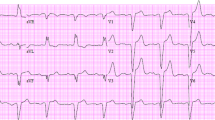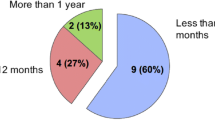Abstract
Little is known about the outcomes of children with second-degree heart block. We aimed to determine whether children with structurally normal hearts and Mobitz 1, 2:1 block or Mobitz 2 are at increased risk for progressing to complete heart block (CHB) or requiring a pacemaker (PM) at long-term follow-up. We searched our institutional electrophysiology database for children with potentially concerning second-degree block on ambulatory rhythm monitoring between 2009 and 2021, defined as frequent episodes of Mobitz 1 or 2:1 block, episodes of Mobitz 1 or 2:1 block with additional evidence of conduction disease (i.e. first-degree heart block, bundle branch block), or episodes of Mobitz 2. Ambulatory rhythm monitor, ECG, and demographic data were reviewed. The primary composite outcome was CHB on follow-up rhythm monitor or PM placement. 20 patients were in the final analysis. Six (30%) patients either developed CHB but do not have a PM (4 = 20%) or have a PM (2 = 10%). Median follow-up was 5.8 years (IQR 4.4–7.0). Patients with CHB or PM were more likely to have second-degree block at maximum sinus rate (67% vs. 0%, p = 0.003), a below normal average heart rate (67% vs. 14%, p = 0.04), and 2:1 block on initial ECG (50% vs. 0%, p = 0.02). In this study of children with potentially concerning second-degree block, 30% of patients progressed to CHB or required a PM. Second-degree block at maximum sinus rate, a low average heart, and 2:1 block on initial ECG were associated with increased risk of disease progression.


Similar content being viewed by others
References
Meytes I, Kaplinsky E, Yahini JH, Hanne-Paparo N, Neufeld HN (1975) Wenckebach A-V block: a frequent feature following heavy physical training. Am Heart J 90(4):426–430
Zeppilli P, Fenici R, Sassara M, Pirrami MM, Caselli G (1980) Wenckebach second-degree A-V block in top-ranking athletes: an old problem revisited. Am Heart J 100(3):281–294
Viitasalo MT, Kala R, Eisalo A (1982) Ambulatory electrocardiographic recording in endurance athletes. Br Heart J 47:213–220
Stein R, Medeiros CM, Rosito GA, Zimerman LI, Ribeiro JP, Porto AS (2002) Intrinsic sinus and atrioventricular node electrophysiologic adaptations in endurance athletes. J Am Coll Cardiol 39(6):1033–1038
Brodsky M, Wu D, Denes P, Kanakis C, Rosen KM (1977) Arrhythmias documented by 24 hour continuous electrocardiographic monitoring in 50 male medical without apparent heart disease students. Am J Cardiol 39:390–397
Dickinson DF, Scott O (1984) Ambulatory electrocardiographic monitoring in 100 healthy teenage boys. Br Hear J 51:179–183
Young D, Robert Eisenberg F, Fish B, Fisher JD, Bronx F, York N (1977) Wenckebach atrioventricular in children and adolescents block (Mobitz type I). Am J Cardiol 40:393–399
Villain E, Bonnet D, Trigo C, Iserin L, Sidi D, Kachaner J (1996) Outcome of, and risk factors for, second degree atrioventricular block in children. Cardiol Young 6:315–319
Solomon MD, Yang J, Sung SH et al (2016) Incidence and timing of potentially high-risk arrhythmias detected through long term continuous ambulatory electrocardiographic monitoring. BMC Cardiovasc Disord. https://doi.org/10.1186/s12872-016-0210-x
Liu CM, Chang SL, Yeh YH et al (2021) Enhanced detection of cardiac arrhythmias utilizing 14-day continuous ECG patch monitoring. Int J Cardiol 332:78–84
Huhta JC, Maloney JD, Ritter DG, Ilstrup DM, Feldt RH (1983) Complete atrioventricular block in patients with atrioventricular discordance. Circulation 67(6):1374–1377
Ho SY, Fagg N, Anderson R, Cook A, Allan L (1992) Disposition of the atrioventricular conduction tissues in the heart with isomerism of the atrial appendages: its relation to congenital complete heart block. JACC 20(4):904–910
Liberman L, Silver ES, Chai PJ, Anderson BR (2016) Incidence and characteristics of heart block after heart surgery in pediatric patients: a multicenter study. J Thorac Cardiovasc Surg 152(1):197–202
Anderson JB, Czosek RJ, Knilans TK, Meganathan K, Heaton P (2012) Postoperative heart block in children with common forms of congenital heart disease: results from the KID database. J Cardiovasc Electrophysiol 23(12):1349–1354
Fish AE, Pride YB, Pinto DS (2008) Lyme carditis. Infect Dis Clin North Am 22(2):275–288
Rein AJJT, Mevorach D, Perles Z et al (2009) Early diagnosis and treatment of atrioventricular block in the fetus exposed to maternal anti-SSA/Ro-SSB/La antibodies: a prospective, observational. Fetal Kinetocardiogram-Based Study Circ 119(14):1867–1872
Charles R, Holt S, Kay JM, Epstein EJ, Russell RJ (1981) Myocardial ultrastructure and the development of atrioventricular block in Kearns-Sayre syndrome. Circulation 63(1):214–219
Salameh A, Gebauer RA, Grollmuss O, Vít P, Reich O, Janoušek J (2008) Normal limits for heart rate as established using 24-hour ambulatory electrocardiography in children and adolescents. Cardiol Young 18(5):467–472
Fleming S, Thompson M, Stevens R et al (2011) Normal ranges of heart rate and respiratory rate in children from birth to 18 years of age: A systematic review of observational studies. Lancet 377(9770):1011–1018
Silka MJ, Shah MJ, Silva JNA et al (2021) 2021 PACES Expert Consensus statement on the indications and management of cardiovascular implantable electronic devices in pediatric patients: executive summary. Hear Rhythm 18(11):1925–1950
Funding
This research received funding from Matthew’s Hearts of Hope (MHOH) Inc. MHOH had no role in study design, data collection or analysis, manuscript writing, or submission for publication. The authors have no relevant financial or non-financial interests to disclose.
Author information
Authors and Affiliations
Contributions
RE, LL, and ES contributed substantially to the study design, data analysis and interpretation, and the writing of the manuscript.
Corresponding author
Ethics declarations
Conflict of interest
The authors declare no competing interests.
Additional information
Publisher's Note
Springer Nature remains neutral with regard to jurisdictional claims in published maps and institutional affiliations.
Rights and permissions
Springer Nature or its licensor (e.g. a society or other partner) holds exclusive rights to this article under a publishing agreement with the author(s) or other rightsholder(s); author self-archiving of the accepted manuscript version of this article is solely governed by the terms of such publishing agreement and applicable law.
About this article
Cite this article
Epstein, R., Liberman, L. & Silver, E.S. Long-Term Follow-Up of Second-Degree Heart Block in Children. Pediatr Cardiol 44, 1529–1535 (2023). https://doi.org/10.1007/s00246-023-03195-w
Received:
Accepted:
Published:
Issue Date:
DOI: https://doi.org/10.1007/s00246-023-03195-w




